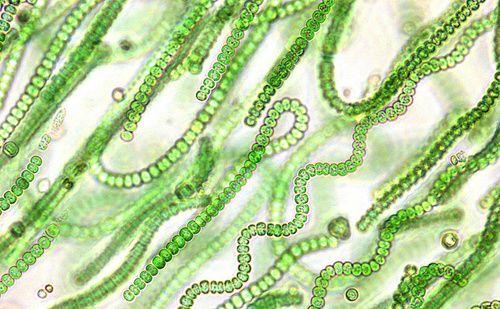The blue algae they have antioxidant, immunostimulating and anticancer properties, and are useful for the health of the skin and body. Let's find out better
> 2. Ownership and use of blue algae
> 4. Contraindications

Description of the algae
The blue algae they are prokaryotic and autotrophic unicellular bacteria of very ancient origin, dating back to more than three billion years ago, more commonly known as cyanobacteria and scientifically as Cyanobacteria, Cyanophyte, Myxoficee, Schizoficee or Cianoficee.
They have been found in fossil remains from Canada, South Africa and Australia. The blue-green algae were the first oxygen producers on the planet and are at the origin of the biological and food chains.
Edible species can be considered one of the most concentrated food sources known and provide an excellent nutritional and energy supply.
Properties and use of blue algae
The blue algae, or those that have blue-green shades, are commonly called blue for their color, which is such thanks to a pigment called phycocyanin, able to hide the green color of chlorophyll; in addition to this pigment, it is possible to find in cyanobacteria allophycocyanins and phycoerethrins.
They grow and reproduce by asexual splitting in thermal or cold waters and in sweet or salty ones. There are about 2.000 species of blue algae. Among these are the best known "particular" microalgae, Spirulina, Klamath e Chlorella, commonly called blue-green algae, although this usage is incorrect, because "algae" is a term now limited only to eukaryotic organisms, while Spirulina, Klamath and Chlorella are classified as "cyanobatteri prokaryotic".
As for the red algae, also the blue ones contribute to the formation of carbonate platforms, like those of coral reef, for example: thanks to photosynthesis, they favor the precipitation of calcium bicarbonate.
All the varieties of blue algae are able to produce cyanotoxins or toxins useful to the algae themselves as a defense from other unicellular algae, protozoa or potentially dangerous microorganisms.
The blue algae manage to live in extreme living conditions, transforming themselves into spores through a process called sporulation; in symbiosis with mushrooms, they form i lichens.
What are the enemy algae of cellulite and how they work

Benefits of blue algae
Some species of blue algae, such as Arthrospira platensis and Arthrospira maxima Kütz, for example, are grown on phytotherapeutic purpose and bandage.
They are in fact grown, dried and freeze-dried to be used for the preparation of supplements, as some species contain a lot of proteins. Arthrospira platensis, in particular, is used because it is rich in mineral salts, vitamins and gamma-linolenic acid, an essential fatty acid; this algal species also contains a small amount of Vitamin B12.
Antioxidant, immunostimulating and anticancer properties are ascribed to the blue algae. There are many other vitamins present:
- beta-carotene, useful for the eyes,
- B vitamins that protect the nervous system, heart and bones,
- vitamin D which protects the immune system and remineralizes bones,
- vitamin E which is antioxidant and immunostimulating.
Due to the peculiarity of their active ingredients, they are used in the formulation of cosmetic products and aesthetic care, in particular for algotherapy and thalassotherapy.
In the cosmetic field, their richness in mineral salts, including iodine in high concentrations, makes them capable of activate physiological mechanisms in the deep layers of tissues, promoting drainage, toning and firming; they are therefore particularly useful for fighting cellulite, water retention and skin relaxation.
Controindicazioni
Algae are generally contraindicated for people sensitive to iodine and for those suffering from hyperthyroidism, and so are blue algae.
These are people whose basal metabolic rate, already quite fast compared to the average, is further accelerated by iodine. Algae are equally contraindicated only for those who must follow very strict low-sodium diets.
Like all algae, even the blue ones can be subject to possible contamination by microcystins or heavy meltalli and toxic substances: this is a problem that affects most of the planet's aquifers.
READ MORE
The properties, use and contraindications of the spirulina algae


























